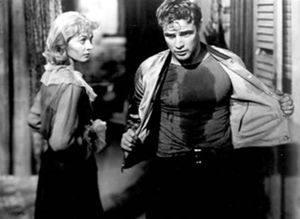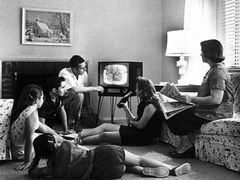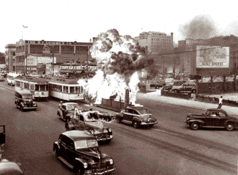Stanley and Sisters

American television series Stanley and Sisters was a short-lived sitcom produced by Paramount Studios in 1968 as a spin-off from the classic movie A Streetcar Named Desire. It featured the main characters from the original play back together and living as a happy dysfunctional family in a world of belly laughs and casual domestic violence. The production was cancelled halfway through the first series, and the shows never officially aired. Today it is believed all existing copies, notes and documents relating to this series were destroyed in the mid 1970s to make space for recorded episodes of Star Trek dubbed into Cantonese.
Background[edit | edit source]
Tennessee Williams’ play ‘A Streetcar Named Desire’ centered around a character named Stanley Kowalski. He was most famously played on the original Broadway run and subsequent silver screen adaptation by Marlon Brando, and apparently once by Alec Baldwin in colour. Stanley is working-class man who delights in his marriage to the socially superior Stella. In the play, Stella’s sister, Blanche, a relic of the Old Southern belle lifestyle, comes to live in the Kowalski household in New Orleans. She serves as a painful reminder to Stanley of his wife’s higher status in society. The clash of Stanley and Blanche becomes the focus of the play, the matter ending in Stanley’s rape of Blanche, and his exclusion from Stella’s life.
Concept[edit | edit source]
In 1962 the rights to Stanley, Stella and Blanche were leased to Paramount Studios by Tennessee Williams, after he had to finance the Broadway run of his experimental piece How Much Is That Doggie in the Electric Chair? The characters were left dormant until 1967, when the potential for a sitcom was realized by Daniel 'Dan' Fanny, then head gardener at Paramount's vegetable garden lot and aspiring television writer/producer.
| “ | I saw the contract hanging out of a garbage bag. I found the characters intriguing when I first saw the film, and thought it was a travesty they were left to rot.
I thought, ‘what if Stanley went back, cap in hand, and was taken back into the house', as Williams intended… that would bring up some difficult situations. |
” |
Using his initiative (and blackmail), Fanny secured the funding from Robert Evans, then Head of Production at Paramount for a pilot.
The Writing Process[edit | edit source]
In late 1967, Dan, began writing the project with his room-mate, Neil Cauldron, former NFL Baseball player and now a regular heroin user. As Dan Fanny recalls:-
“It took almost three days to write the pilot … we started early every day, and bounced ideas back and forth. In those three days we had written the pilot, and planned seasons one through seven. We were reasonably confident we could carry on that far. Neil’s dealer really helped, he reduced the dosage by mixing it with cough mixture so we became more productive. I can tell you Stanley and Sisters was written with Sergeant Pepper's Lonely Heart Club Band and Pet Sounds wafting through my apartment.
Casting[edit | edit source]
Many people were approached with regards to the role of Stanley, including the role’s original casting, Marlon Brando. Already known for his 'pain in the ass' acting style, Brando expressed an initial interest in returning as Stan and promised to stay off the donuts whilst he got into better shape. He was also was conscious that critics would jibe that Brando was only returning to the role in order to burgeon his rapidly failing career, even if he would now play Stan for canned studio laughter. Changing Stan from a tragic character to a sofa-bound slob with comic overtones didn't seem to bother Brando too much but he was concerned that the hectic working schedule of a sitcom would be prevent him from working on any new big budget films. Regardless, he agreed to participate for a fee of $14 million. Paramount refused to pay this amount, despite the insistence (and further blackmail) of Fanny. As he was later to write, 'I guess, I just wasn’t Francis Ford Coppola.'
Frantic searches were undertaken to find a young exuberant actor to take the part. Auditions were very scarcely attended, as many didn’t wish to fill Brando’s sizable moccasins. It was looking desperate, Fanny even suggested Mickey Dolenz from The Monkees as a possible lead in if no one else turned up.
| “ | Then along came David Proval. He blew us away. He might have been the only actor there, but I am sure, he would have beaten anybody else had they shown up.We told Proval to strip off his paisley shirt and wear what is now known as the 'wife beater' style teeshirt. He looked good, he could also do the cruel smile that made Brando so menacing. I told Neil Cauldron, 'we've got our Stan'. | ” |
Vivien Leigh wasn't available to play Blanche as she had just died so Yvette Mimieux was cast as the alcoholic, nymphomaniac faded beauty. The future Cagney and Lacey star Tyne Daly got the role of Stella whilst Blanche’s main love interest (and Stanley’s best friend) Mitch also returned in the show. He was played by Marshall Bell who would later go on to appear in the first version of Nightmare on Elm Street.
For reasons that Fanny can't now remember, Andy Warhol was brought in as art designer for the show. He thinks Warhol simply posted his work in and designed the main title card. If Paramount were aware of Warhol's involvement in Stanley and Sisters, they have made no mention of it in subsequent press releases. Nor did Warhol but the consequences of what he had done on the show would have dire consequences.
Pilot[edit | edit source]
The pilot show was shown to studio executives in early 1968. It started with Stanley arriving home, to find Stella leaving the house. He convinces her he is changed man, who sees the error of his ways. Stella runs to his arms, and agrees to stay, provided he and Blanche patch up their differences, and she can return from the asylum permanently. They agree. As Stella takes her bags up stairs, Stanley and Blanche agree to sit and talk. They then get into a humorous argument about Stanley cutting his toenails in the living room.
Many of the studio executives at Paramount were not aware of the ending of the original play, and as the script never made mention of the rape at the end. Davy Pratt, talent executive at Paramount:
| “ | We thought that the toenail bit was hilarious. We saw huge comic potential with the snobbish sister in law and the lazy, working-class husband. He was the everyman, someone everyone could identify with, and she was like the classic mother-in-law character, but with style and poise. We thought that Stanley telling Blanche "I’ll get you again while you sleep" could have really taken off… like a catchphrase kind of thing. That was actually one of the reasons we green-lighted it. We even had some white T-shirts printed up. We thought we had the next Beverly Hillbillies. | ” |
Further Shows[edit | edit source]
The further episodes featured Blanche as a foil to Stanley’s efforts, namely by getting a part-time job at his bowling alley, becoming a regular at his favourite bar, and by bringing her ‘gentleman friends’ back to the house, whilst Stanley is relaxing. These spats were often mediated by Stella, confined to the role of a straight man. The shows were punctuated by Cauldron’s punchy, drug-addled dialogue. Some of the show's plots included: Stanley nearly bowling a perfect game, which Blanche ruins in the last frame by distracting him; Blanche bringing a beau back to the house whilst Stanley is listening to the game. Stanley counteracts this by encouraging him to ignore Blanche’s advances, and joining him in listening to the radio. These early shows got good ratings from test audiences, with many men identifying with social pressures Stanley was put under.
The Fifth Show[edit | edit source]
“I never intended the show to betray the characters of the play. Neil and I were always adamant about that. Stanley was always going to be an animal, a monster, but would have a comic side. So would Blanche, but she would still be a man-eating drunk … I don’t understand why the execs flipped … kids' shows cover these kind of issues now.”
– Dan Fanny
The fifth show was fully recorded on a closed set. This was to protect the storyline from burgeoning press interest. The pilot show had been shown to a test audiences in early 1968 but the response said Fanny was 'negative', 'hostile' and 'Is this the The Munsters? '. The producers then decided to show the fifth episode to a more representative audience, excluding anyone who looked too much like anyone in the cast.
It began with Stanley planning a fishing trip with Mitch. As they were ready to leave, Blanche invited lovable loser Mitch to dinner, with a view to rekindle their affection. Mitch agreed and left Stanley in the lurch. Stanley was left to drink all night at his favourite bar. As he stumbles through the door, he finds Mitch and Blanche holding hands on the couch. He beats Mitch to a bloody pulp with a tyre iron. He then punches the screaming Blanche in the face, and begins to advance on her menacingly.
Unfortunately, we did not know what happened next, as the projector at the showing was immediately switched off. Creator Fanny is also notoriously tight-lipped about the rest of the episode, believing that the his vision could not be adequately described as it was on film. “We always knew that’s who Stanley was… it’s a shame that it was never shown, just closed down by the petty minds of inaccessible studio bosses.”
Backlash[edit | edit source]
Though Stanley and Sisters was never broadcasted, advertisements promoting the show had already been seen in the press. A trailer was also made for television but it was also never shown and is now presumed lost. However, the content of the fifth episode were leaked and Dan Fanny's co-writer Neil Cauldron agreed to be interviewed by the Los Angeles Times. In that article he said 'rape was a rich source of comedy', comparing it to the eighteenth century The Rape of the Lock by the English poet/writer Alexander Pope.
The response to Cauldron's flippant comparison was the direct cause of the first L.A. Riot connected with a television show. In the confusion and burning tyres, Neil Cauldron was lynched by a group called the Feminist Liberators Against Neverending Girly Entertainment (F.L.A.N.G.E.). They were said to be the Los Angeles branch of Society for Cutting Up Men lead by Valerie Solanas. The F.L.A.N.G.E. sent castrated G.I.Joe dolls to every Hollywood executive as a warning to them not to show Stanley and Sisters. Solanas took her protest further by shooting and wounding Andy Warhol in New York for his involvement in the TV series.
To escape the backlash Fanny was forced to live underground in the storm sewers of Los Angeles until the fuss died down. He resurfaced in the later years of Hollywood, obtaining injury compensation money to finance further projects. Fanny later wrote his version of the story but then sold his rights to Eminem who turned it into the song Stan.
| “ | Look...it was just too ahead of its time. The idea that you could make a sitcom out of a violent drama was considered just too way out there but now it's done all the time. What is The Sopranos but just The Godfather played for laughs or any films featuring Tom Hanks?? It's a shame Cauldron died as he was a great writer. I am sure we could have made a good living off this show if it had been transmitted. Perhaps he would have been dead by series three but..yeah, I can be bitter and twisted like any other schmuck who pawns his soul to Hollywood. | ” |
As the show never made it to air, the actors were not tarred with Fanny's brush (although there were rumours about David Proval). They all went on to have moderately successful careers in the industry, regardless of how badly they may have aged. Fanny hopes one day the series will be re-shot but now considering shows like Jerry Springer, Jersey Shore and Keeping Up With The Kardashians now dominate popular television slots, he thinks the mistake was to have shot it as a sitcom rather than a reality show.




